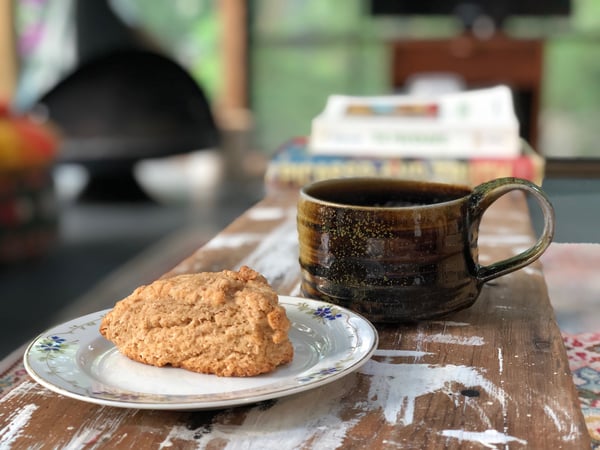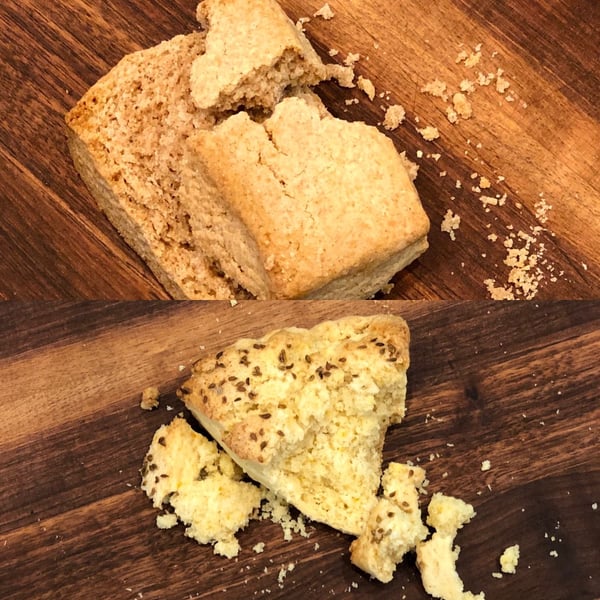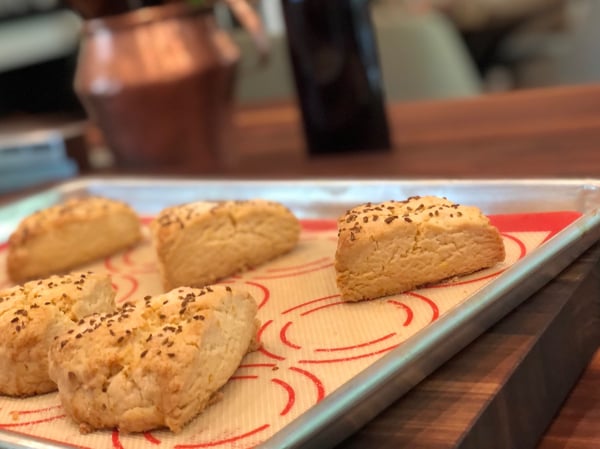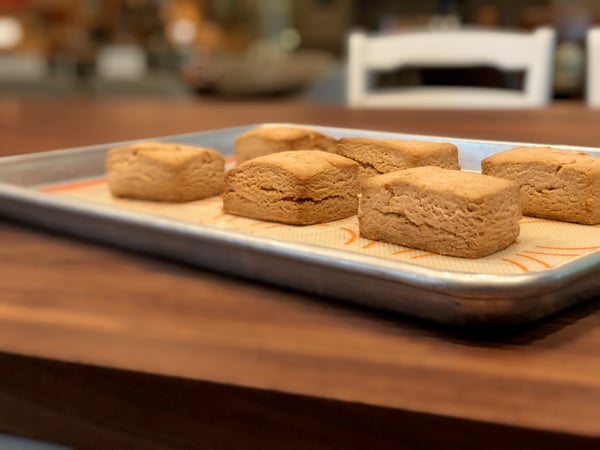Scones, Biscuits and Shortcakes

I regularly make scones or biscuits for breakfast as a special treat. I love making these for so many reasons but especially because I think it is nearly impossible to find a good scone, or at least the kind of scone I like. One exception might be the Whistle Stop in Union Pier, MI which has the best scones I have ever tasted!
I love that I can make a scone or biscuit without a recipe, I can easily change the flavor profile, and I can make a small quantity so I am not stuck with a large quantity on hand that I feel obliged to eat! People are always impressed when you make homemade biscuits or scones so they are perfect when you have houseguests or want to impress.

Technically a scone and a biscuit are shortcakes, but I am not sure most people are aware of that. It seems kind of crazy because there are so many versions of all three and some very strong opinions about how each one of these should be made.
Biscuits can especially stoke intense debates between regional styles and preferences. What I want to share with you today is more of a formula for making a shortcake, biscuit or scone rather than a specific recipe. Alongside this formula I am going to show you how you can shift the ingredients to change the texture and style of your scone, biscuit or technically your shortcake. Some people want a velvety soft biscuit and some people prefer a light and crispy biscuit. The formula and information below I hope will assist you in making them anyway you prefer!
Shortcake, Scone, Biscuit Formula
Yields 6
2 cups flour
1 teaspoon to 1/4 cup of sugar
2 Tablespoons baking powder
Pinch of salt
6 Tablespoons fat
1/3 to 1 cup liquid
Optional Ingredient Additions:
1/2 to 2 teaspoons seasonings such as cinnamon, nutmeg, rosemary, chives or citrus zests
1/4 to 1/2 cup dried fruit, chocolate chips, fresh fruit, grated cheese, crumbled bacon or sausage
Optional Toppings:
Brush with egg wash, heavy cream or melted butter.
Sprinkle top with sugar, sprinkles, whole spices such as fennel seed or coriander.
Mixing Method
- Put dry ingredients into a food processor: flour, sugar, baking powder and salt. Add the optional seasonings here if you are using them. Pulse till combined.
- Add fat and pulse until the mixture is crumbly.
- Add liquid and pulse until the dough just comes together.
- If adding optional dried fruit, chocolate chips or bacon, stir them in.
- Press onto a lightly floured surface to about an inch and a half think and cut into triangles, circles or whatever shape you like.
- Brush with optional egg wash, butter, milk or cream and sprinkle with sugar or spices if desired.
- Bake at 375 degrees for about 20 minutes.
Let’s start by unpacking each ingredient in this formula. I’ll outline what each ingredient does so you can have a better understanding of how and when you might choose to change them.
Flour
Flour creates structure, it basically holds things together with something called gluten. When you add liquid to wheat flour (all-purpose or bread flour) and mix it together, it gets stringy, right? That stringiness is gluten starting to form. Most people don’t realize that flour is protein at its core and that different flours have different protein content. The more protein a flour has, the more flavor and strength the dough will have. Think white bread versus a baguette, the baguette is made from a very high protein flour, that creates a dense bread with lots of flavor and a crisp crust. White bread is soft and has less flavor and a soft crust because it is made from a low protein flour.
You can play around with different flours and combinations of flours to create different textures and tastes in your formula.
- All-purpose flour or AP flour has a medium in protein content. It gives a moderate amount of flavor and texture.
- White Lily flour or cake flour are very low protein flours providing a very light soft texture and taste.
- Bread flour gives the most flavor and structure because it has the highest protein content.
- Whole wheat flour has the bran and germ attached; these interfere with gluten development which provides less structure to the bread. Although it provides less structure, whole wheat can provide additional flavor and crispness to your dough when used in combination with white flour.
Sugar
Sugar creates sweetness, which I think most people understand, but sugar also tenderizes and aides in browning. All sugar has a similar sweetness level but different sugar tastes differently and affect texture differently. The more sugar you add to a dough the flabbier your dough can get, what I mean by that is the dough's texture gets loose as the grains of sugar interfere with gluten formation, so the more you add the dough will be sweeter but it will also be softer.
Sugar also aides in browning so the less you use in the dough, the paler your shortcake will be. We also sprinkle sugar on the top of our shortcakes to kick up the appeal.
- White sugar provides a clean taste. The granules are small so it interferes the least with gluten development. White sugar will provide the crispest texture to your shortcake of the sugars listed.
- Brown sugar has molasses added which adds a lot of interesting flavor but also adds moisture. The density and moisture of this sugar really softens the dough.
- Demerara sugar has the biggest crystal formation and does not combine well in the dough. It is, however, great for topping the scones if you want a crunchy sugar topping.
Leavening Agents
You need something to make the dough rise and my go to is a double-acting baking powder. Really all baking powder you find these days is double acting so I wanted to highlight that here. In the formulas listed when I say baking powder it implies double acting baking powder. Since you cannot simply substitute baking soda for baking powder, just stick to baking powder ratio in the formula and you will be good to go.
Liquid
The essential function of liquid is to mix with the flour and create the gluten. If flour is the Yang of the shortcake, water is the Yin. Usually we use a rich liquid such as milk, cream or buttermilk since the richness of their fat add a nice mouth feel to the dough. The fat also assists in keeping the gluten from getting too strong. The key to a great shortcake is the balance of texture and tenderness, gluten provides texture and fats and sugars provide tenderness.
- Milk is commonly used. I personally use whole milk because I like the fat and the texture it creates. Feel free to use whatever you have on hand, you can always up the butter a tablespoon or two if you want that addition of fat.
- Cream is also used, especially in biscuits since many people prefer them very tender. Cream has the most fat of these liquids, hence provides the most tenderness.
- Buttermilk like milk can be skim or with fat, so the same comments I made about milk and cream would apply to your buttermilk, just note what the fat content is. Buttermilk provides acidity to the dough which is also a tenderizer.
- Eggs are sometimes used in shortbread as well. Eggs add a lot of moisture so consider them a liquid as far as a ratio in this formula goes. You will likely need to add a few tablespoons of water or milk to a shortcake with eggs since the liquid from the eggs is so thick. The egg will add structure since it is largely protein but it also adds fat which will enrich your shortcake.
Fat
Fat is primarily used for texture and mouthfeel but clearly adds flavor to your shortbread. Fat adds texture in two ways, one by minimizing gluten development and secondly by the richness it leaves in your mouth or what we call mouthfeel. Remember gluten is protein and the more you work it the stronger it gets; the fat keeps the gluten from getting too strong and tough.
- Butter provides a lovely flavor. It also melts at a very low temperature which ultimately yields the lowest volume in your shortbread. If you have baked a cookie made with butter you know what I mean, it spreads out when you bake it rather than being thick and chewy. I want to clarify that you can make a nicely risen shortbread with butter it may be less risen than when you use one of the other fats listed below. Butter also provides tenderness and a more crumbly texture.
- Shortening or margarine have high melting points and yield more perky and high shortbreads. Shortening isn’t much of a contributor in the flavor category and you may or may not like the flavor of margarine that is up to you. Shortening and margarine offer a flakier texture than butter.
- Lard has a higher melting point that butter and a lovely flavor but a very distinct flavor that may not suite some applications. Lard also provides a more densely flaky texture.
Egg, Milk or Heavy Cream Washes
What a confusing subject this seems to be, what and when to use these to brush on your baked goods. The main reason for applying these washes to the top of your shortbread is to boost the appearance or to make sure your sprinkling of sugar on the surface stick to the shortbread.
- Egg wash can be just the yolk and water or the whole egg and water. Sometime other liquids such as milk can be added as well. An egg wash will add the most color and gloss to your pastries which is great but it also creates the hardest layer on the top. I reserve egg washes for soft breads and firm pastries like pretzels, puff pastry or more savory applications. If I were to do a bacon cheddar scone, egg wash might be my choice.
- Milk and heavy cream pretty much do the same thing, which is to improve appearance and browning but without gloss and hardness. Heavy cream has more fat and protein and will adhere better than milk, therefore you will get more browning from the heavy cream than the milk, especially if you are using skim milk.
- Butter is used primarily after baking to enrich the shortcake.

Let’s put this formula and my notes into practice. You will notice I did not change the total ratio of each category of ingredient but rather changed some of the ingredient combinations to total the same ratio as in the above formula. Ultimately these two recipes should yield a very similar style and texture although the ingredients have been changed.

Orange and Anise Scone
1 cup all-purpose flour
1 cup bread flour
3 Tablespoons granulated sugar
2 Tablespoons baking powder
Pinch of salt
1 teaspoon orange zest
6 Tablespoons unsalted butter
1/3 cup plus 2 Tablespoons heavy cream
Brush scones with heavy cream and sprinkle with sugar and anise seeds:
1 tablespoon heavy cream
2 teaspoons anise seed
2 teaspoons sugar
My rationale behind this formula
When I think scone, I think butter so I always use it when I make them. I knew I wanted to use heavy cream as well… a nod to clotted cream. With all that yummy richness and tenderizing qualities of the fat I could afford to add some bread flour and gain some of the added flavor and it provides. The bread flour will also provide some extra structure to support the low melting point of the butter.

Brown Sugar and Cinnamon Biscuits
1 1/2 cup all-purpose flour
1/2 cup whole wheat flour
1/4 cup brown sugar
2 Tablespoons baking powder
Pinch of salt
1 teaspoon of cinnamon
6 Tablespoons lard
1 teaspoon vanilla
1/3 cup milk
My rationale behind this formula
Lots of brown sugar will soften the dough so I added the whole wheat flour for additional crispness. The lard provides a higher melting point and more height to offset the high amount of brown sugar. Also, I like to serve this biscuit with bacon and the lard is so yummy with it.
I know this is a lot of information to digest but have fun playing around with your new formula. The sky is the limits for your creativity, and if you stick to this foolproof formula any combination should yield a great result, whether it be a biscuit, scone or shortcake… because as we established, they are pretty much the same thing. If you want to hear more on the subject or want to ask questions of me directly, join me in my upcoming virtual Strawberry Shortcake class on Saturday, June 13 at 11am CST.

